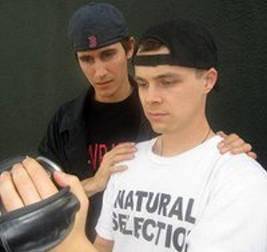
Few L.A. theater projects have had quite the success (or the journey) of The Columbine Project, Paul Storiale’s meticulously researched docudrama about the Columbine High School massacre of 1999. World premiering in April of 2009 at the 48-seat Avery Schreiber Theatre in North Hollywood, The Columbine Project was extended twice before transferring to off-Broadway with unprecedented swiftness (and with the entire L.A. cast intact). Its July through October New York run at the Actors Temple Theatre was praised by the prestigious New Yorker magazine as a production which “fills the tiny, funky theatre with talent and gravity.” In December of the same year, the original North Hollywood production was awarded five ADA (Artistic Director Achievement) Awards including a Best Director award for its creator/writer/director Paul Storiale.
For most plays, this would probably have been the end of the road, but not The Columbine Project. Less than a year after its initial run, Storiale’s gripping, informative play returned to the Avery Schreiber minus an hour of the original three-hour running time and with an almost entirely new cast.
Since then, a screenplay has been written and workshopped, and The Columbine Project now celebrates the second anniversary of its original production with a third staging at the Schreiber, one which features four original cast members, one from cast number two, and thirteen newbies.
As before, The Columbine Project moves backwards and forwards in time like a patchwork quilt of events, introducing us to mass murderers Eric Harris and Dylan Klebold’s teachers, classmates, and other Coloradans whose lives were changed forever on that April day.
We meet a TV reporter (Jack Millard) broadcasting live from the site of the massacre, his hand his hands trembling. “It is a war zone down here,” he declares over the sounds of helicopters circling above. “Information is very scarce now as the gunpersons are still at large.”
We meet Dylan’s childhood friend Brooks Brown (Carson Higgins), a different sort of Columbine victim. “My friends did this and I was blamed for it, maligned and traumatized,” protests Brooks who, after the shootings, was offered a diploma in exchange for never going back to school again.
We meet Chris Taylor (Scott Chesak), a gay student tormented by jocks and befriended by fellow student Rachel Scott (Sara Swain). When Rachel finds a tearful Chris, she offers him Kleenex and sympathy. “God loves you for how he made you,” she tells him, revealing herself to be the kind of open, accepting Christian not usually depicted on stage, film, or TV. Rachel Scott would be Eric and Dylan’s first victim on that April day in 1999.
We meet Wayne and Kathy Harris (Rich Skidmore and Paige Kimball) and see, not the defective, easy-to-blame parents we are expecting, but a loving couple who found it all too easy to ignore the warning signs their son was exhibiting.
We meet lawyer Alice Sparks (Bree Pavey), hired by families of the victims. Why did it take so long for law enforcement officers to enter the school building? Why are there so many holes in the police reports? A teacher’s open cell phone recorded 26 minutes of what was taking place in the library. Why won’t the police let the families hear the tape?
We meet Eric’s well-intentioned but clueless psychiatrist Dr. Nice (Millard again), so taken in by Eric’s act that all he does is to prescribe drugs—to “level your head.”
We meet Mrs. Kritch (Kimberly Jurgen), teacher of Eric and Dylan’s Chinese Philosophy class, who didn’t see the warning signs in Eric’s talk about Hitler.
We meet Vonda Shoels (Pamela Taylor), the mother of Isaiah Shoels, shot and killed for being a “nigger.” In tears, Vonda expresses how angry she still is at the teacher who could have done something by getting the students to barricade the library doors, but who spent five minutes with 911 before saving herself by hiding in a cupboard.
We meet Isaiah (Paul Woolfolk), a boy who’d learned to use humor to get other kids to like him, telling his mother, “One day I’m going to be the President!” and we hear his proud mother’s reply. “Hold on to those dreams. You can be whatever you want to be.”
We meet Columbine High School teacher “Mrs. Miller” (Pavey again) who overhears jocks Seth and Jake calling Brooks “faggot,” and defying our expectations, reprimands Brooks for making the athletes angry. “They have a game next week!” she reminds him, her voice devoid of compassion for the real victim.
We meet other Columbine High School students (brought to life by Stacy Allen, Chris Arvan, Joe Cisternelli, Evan Cuthbert, Kristina Diamontoni, Matthew Powell, and Ashley Sugarman), who were part of Eric and Dylan’s life before April 20.
And most importantly, we meet the killers, Alpha Male Eric (Riley Bodenstab) and his disciple Dylan (Morgan Roberts). “They’re going to make video games about us!” Eric proclaims proudly. “Eric and Dylan, the real natural born killers!” We see the boys as they get ready for their killing spree and hear Eric’s shocking declaration, “I wish I was a fucking sociopath so I wouldn’t feel any remorse.” We see Eric, the quick and easy liar, tell his unsuspecting mother that the gun she spots in his room is a pellet gun for a movie he and Dylan are making. “Finish your movie and get back to school,” she tells her son with a goodbye kiss, oblivious to the fact the he and Dylan are about to go on their rampage.
Storiale takes us into the library as the students hear the first shots, believing that it’s nothing to worry about. We see their teacher (Kimball again) making the phone call to 911 that Mrs. Shoels has spoken about previously, repeatedly telling the kids to stay under the tables as sounds of gunfire intensify. We see a wounded Coach Sanders (Skidmore again), knowing that it is too late to save him.
This year’s The Columbine Project runs ten minutes or so longer than its previous incarnation, with several key scenes returning, the play becoming richer and stronger with them restored.
Storiale’s play makes no attempt to excuse Eric and Dylan for their actions, but it does help us understand, or at least gets us thinking about the possible reasons for two boys from “good” families to turn into monsters.
Just like the actors who originated the roles of Eric and Dylan two years ago, and their 2010 replacements, a new pair of gifted young thespians bring the Columbine killers to frightening life. Bodenstab disappears inside Eric’s sociopathic skin and though he is slighter in stature than his two predecessors, the force of his performance makes it easy to believe he could cow the more malleable Dylan into his co-conspirator. Opposite Bodenstab’s star turn is the equally compelling work of original cast member Roberts as Dylan, a role he took over during the play’s New York run. It says something about the nature of self-esteem issues that the runway-ready Roberts plays a character who found himself ugly, and does this both credibly and movingly.
The third “discovery” of this year’s Columbine Project is Higgins as Brooks, though American Idol viewer will be hard-pressed to recognize the haunted-eyed former best friend of Dylan as the goofy surfer dude who earned himself a multitude of Idol fans earlier this year. Higgins’ acting chops match his vocal talents, particularly in a monolog which has the actor’s eyes filling with tears, the kind that cannot be faked.
As she did last year, Taylor devastates as Mrs. Shoals in a stunning monolog which precedes a heartwarming mother-son scene opposite a marvelous Woolfolk as Isaiah, the role he originated. Theater newcomer Chesak impresses as a boy coming to grips with his sexuality in a hostile environment, in addition to performing several songs to his own guitar accompaniment, including the one which provides the show an emotion-packed finale. Once again, original L.A. and New York cast member Swain makes for a lovely, hard-to-forget Rachel, her eyes radiating joy and love in a monolog taken from Rachel’s writings. Swain and Chesak’s scene together is one of the evening’s best acted.
All of the remaining cast members give performances that show their commitment and dedication to the project, with special mention due Pavey and Jurgen for their particularly authentic work.
It should be mentioned that The Columbine Project is L.A. theater at its most bare-boned, i.e. do not go expecting the kind of set, lighting, and costume designs usually raved about in StageSceneLA reviews. The uncredited set design consists of furniture moved on and off the black-walled stage with relative swiftness (and in the dark). Lighting is mostly lights-up, lights-down on the area where the action is taking place. A background of live radio broadcasts, police radio recordings, and heavy metal music (said by some to have fueled Eric and Dylan’s rage) accompany scene changes. Cory Price deserves kudos for his work up in the sound and lighting booth.
Though I still question the logic behind leaving Bodenstab and Roberts on the floor as their castmates take their bows (they are, after all, actors and not the characters they play), the pair do get introduced to loud applause at a post-performance Q&A.
As in years past, there are plenty of reasons to spread the word about The Columbine Project’s return to L.A. In addition to its theatrical merits, it focuses needed attention on the ever-present problem of bullying and violence in our country’s schools. Students and their parents in particular ought to be standing in line for tickets, and there couldn’t be a better guest production for local middle and high schools than The Columbine Project. This is “guerilla theater” at its most powerful, and once again a production well worth seeing.
The Avery Schreiber Theatre, 11050 Magnolia Blvd., North Hollywood.
www.thecolumbineproject.com
–Steven Stanley
May 1, 2011





 Since 2007, Steven Stanley's StageSceneLA.com has spotlighted the best in Southern California theater via reviews, interviews, and its annual StageSceneLA Scenies.
Since 2007, Steven Stanley's StageSceneLA.com has spotlighted the best in Southern California theater via reviews, interviews, and its annual StageSceneLA Scenies.







 COPYRIGHT 2024 STEVEN STANLEY :: DESIGN BY
COPYRIGHT 2024 STEVEN STANLEY :: DESIGN BY